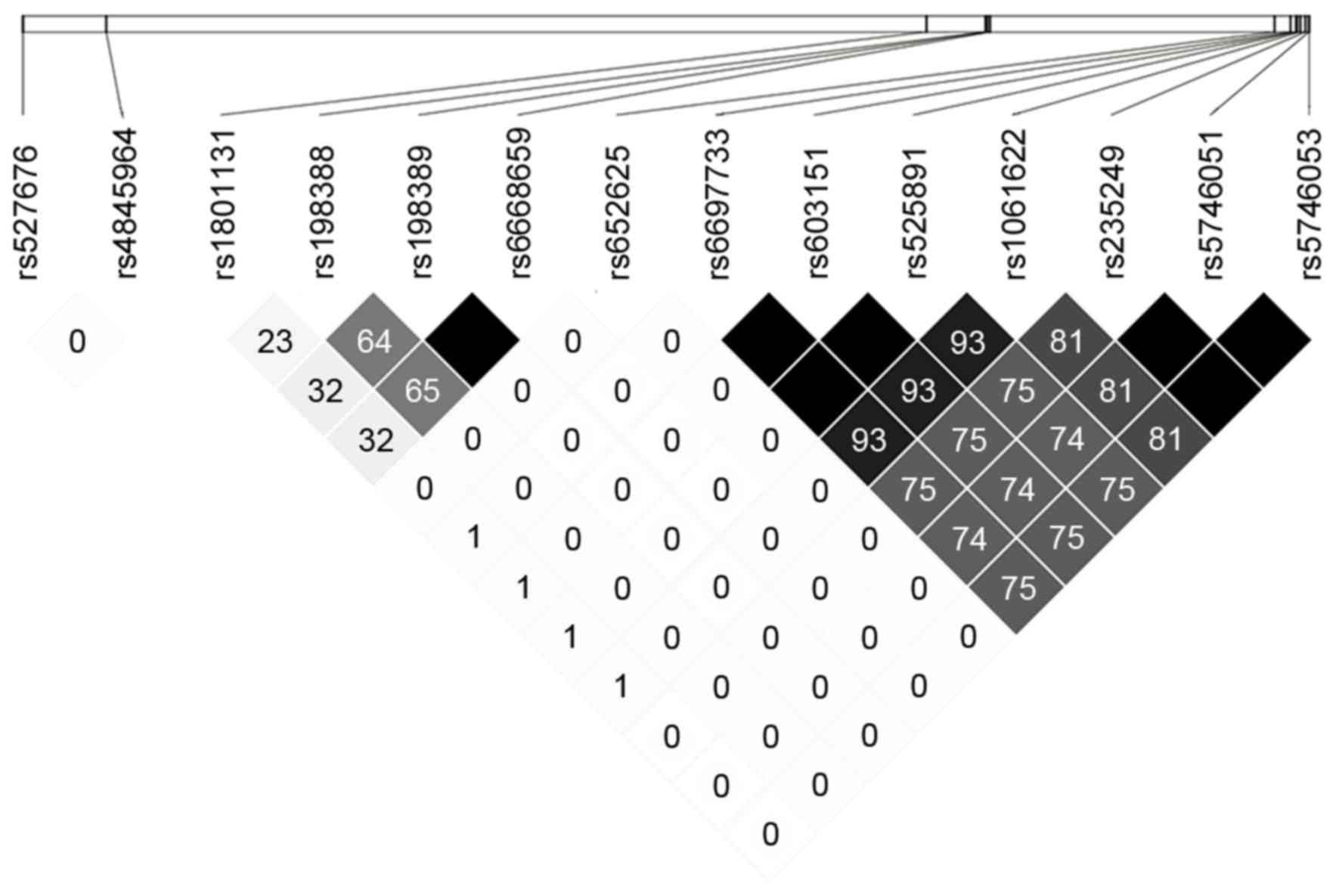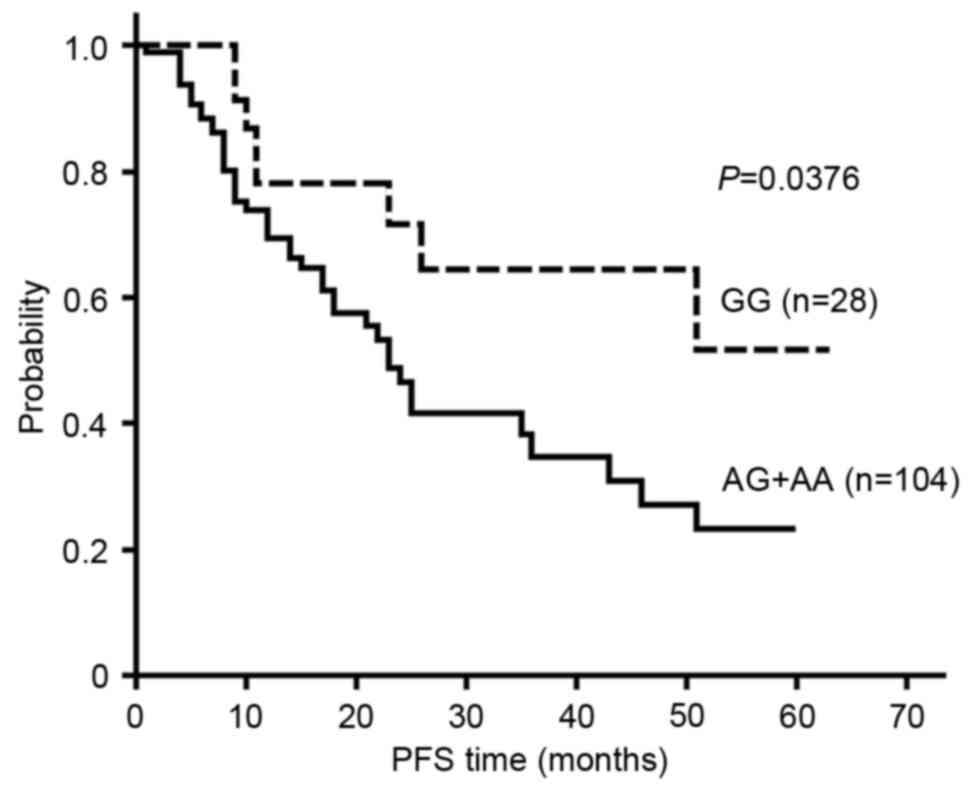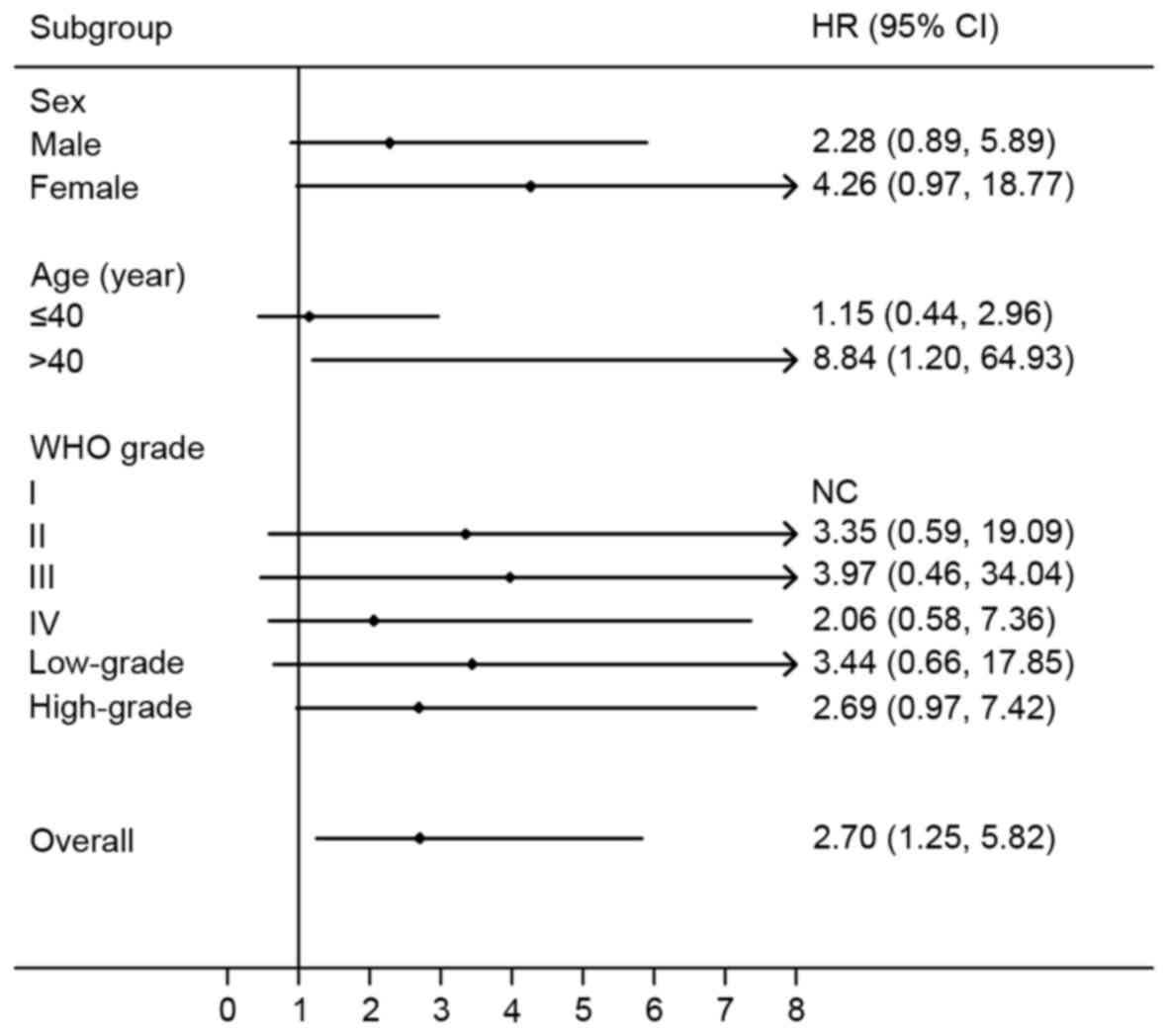|
1
|
Schwartzbaum JA, Fisher JL, Aldape KD and
Wrensch M: Epidemiology and molecular pathology of glioma. Nat Clin
Pract Neurol. 2:494–503. 2006. View Article : Google Scholar : PubMed/NCBI
|
|
2
|
Louis DN, Ohgaki H, Wiestler OD, Cavenee
WK, Burger PC, Jouvet A, Scheithauer BW and Kleihues P: The 2007
WHO classification of tumours of the central nervous system. Acta
Neuropathol. 114:97–109. 2007. View Article : Google Scholar : PubMed/NCBI
|
|
3
|
Siegal T: Clinical impact of molecular
biomarkers in gliomas. J Clin Neurosci. 22:437–444. 2015.
View Article : Google Scholar : PubMed/NCBI
|
|
4
|
Parker NR, Khong P, Parkinson JF, Howell
VM and Wheeler HR: Molecular heterogeneity in glioblastoma:
Potential clinical implications. Front Oncol. 5:552015. View Article : Google Scholar : PubMed/NCBI
|
|
5
|
Laplante M and Sabatini DM: mTOR signaling
in growth control and disease. Cell. 149:274–293. 2012. View Article : Google Scholar : PubMed/NCBI
|
|
6
|
Wullschleger S, Loewith R and Hall MN: TOR
signaling in growth and metabolism. Cell. 124:471–484. 2006.
View Article : Google Scholar : PubMed/NCBI
|
|
7
|
Parsons DW, Jones S, Zhang X, Lin JC,
Leary RJ, Angenendt P, Mankoo P, Carter H, Siu IM, Gallia GL, et
al: An integrated genomic analysis of human glioblastoma
multiforme. Science. 321:1807–1812. 2008. View Article : Google Scholar : PubMed/NCBI
|
|
8
|
Cheng CK, Fan QW and Weiss WA: PI3K
signaling in glioma-animal models and therapeutic challenges. Brain
Pathol. 19:112–120. 2009. View Article : Google Scholar : PubMed/NCBI
|
|
9
|
Kubiatowski T, Jang T, Lachyankar MB,
Salmonsen R, Nabi RR, Quesenberry PJ, Litofsky NS, Ross AH and
Recht LD: Association of increased phosphatidylinositol 3-kinase
signaling with increased invasiveness and gelatinase activity in
malignant gliomas. J Neurosurg. 95:480–488. 2001. View Article : Google Scholar : PubMed/NCBI
|
|
10
|
Gibbs JR, van der Brug MP, Hernandez DG,
Traynor BJ, Nalls MA, Lai SL, Arepalli S, Dillman A, Rafferty IP,
Troncoso J, et al: Abundant quantitative trait loci exist for DNA
methylation and gene expression in human brain. PLoS Genet.
6:e10009522010. View Article : Google Scholar : PubMed/NCBI
|
|
11
|
Schadt EE, Molony C, Chudin E, Hao K, Yang
X, Lum PY, Kasarskis A, Zhang B, Wang S, Suver C, et al: Mapping
the genetic architecture of gene expression in human liver. PLoS
Biol. 6:e1072008. View Article : Google Scholar : PubMed/NCBI
|
|
12
|
Montgomery SB, Sammeth M,
Gutierrez-Arcelus M, Lach RP, Ingle C, Nisbett J, Guigo R and
Dermitzakis ET: Transcriptome genetics using second generation
sequencing in a Caucasian population. Nature. 464:773–777. 2010.
View Article : Google Scholar : PubMed/NCBI
|
|
13
|
Nicolae DL, Gamazon E, Zhang W, Duan S,
Dolan ME and Cox NJ: Trait-associated SNPs are more likely to be
eQTLs: Annotation to enhance discovery from GWAS. PLoS Genet.
6:e10008882010. View Article : Google Scholar : PubMed/NCBI
|
|
14
|
Hulur I, Gamazon ER, Skol AD, Xicola RM,
Llor X, Onel K, Ellis NA and Kupfer SS: Enrichment of inflammatory
bowel disease and colorectal cancer risk variants in colon
expression quantitative trait loci. BMC Genomics. 16:1382015.
View Article : Google Scholar : PubMed/NCBI
|
|
15
|
Huang L, Xu W, Yan D, Dai L and Shi X:
Identification of expression quantitative trait loci of RPTOR for
susceptibility to glioma. Tumour Biol. 37:2305–2311. 2016.
View Article : Google Scholar : PubMed/NCBI
|
|
16
|
GTEx Consortium, . The genotype-tissue
expression (GTEx) project. Nat Genet. 45:580–585. 2013. View Article : Google Scholar : PubMed/NCBI
|
|
17
|
Hernandez DG, Nalls MA, Moore M, Chong S,
Dillman A, Trabzuni D, Gibbs JR, Ryten M, Arepalli S, Weale ME, et
al: Integration of GWAS SNPs and tissue specific expression
profiling reveal discrete eQTLs for human traits in blood and
brain. Neurobiol Dis. 47:20–28. 2012. View Article : Google Scholar : PubMed/NCBI
|
|
18
|
Vigneswaran K, Neill S and Hadjipanayis
CG: Beyond the World Health Organization grading of infiltrating
gliomas: Advances in the molecular genetics of glioma
classification. Ann Transl Med. 3:952015.PubMed/NCBI
|
|
19
|
Fogli A, Chautard E, Vaurs-Barrière C,
Pereira B, Müller-Barthélémy M, Court F, Biau J, Pinto AA, Kémény
JL, Khalil T, et al: The tumoral A genotype of the MGMT rs34180180
single-nucleotide polymorphism in aggressive gliomas is associated
with shorter patients' survival. Carcinogenesis. 37:169–176. 2016.
View Article : Google Scholar : PubMed/NCBI
|
|
20
|
de Castro J Vieira, Goncalves CS, Costa S,
Linhares P, Vaz R, Nabiço R, Amorim J, Viana-Pereira M, Reis RM and
Costa BM: Impact of TGF-β1-509C/T and 869T/C polymorphisms on
glioma risk and patient prognosis. Tumour Biol. 36:6525–6532. 2015.
View Article : Google Scholar : PubMed/NCBI
|
|
21
|
Hegi ME, Diserens AC, Gorlia T, Hamou MF,
de Tribolet N, Weller M, Kros JM, Hainfellner JA, Mason W, Mariani
L, et al: MGMT gene silencing and benefit from temozolomide in
glioblastoma. N Engl J Med. 352:997–1003. 2005. View Article : Google Scholar : PubMed/NCBI
|
|
22
|
Hu X, Pandolfi PP, Li Y, Koutcher JA,
Rosenblum M and Holland EC: mTOR promotes survival and astrocytic
characteristics induced by Pten/AKT signaling in glioblastoma.
Neoplasia. 7:356–368. 2005. View Article : Google Scholar : PubMed/NCBI
|
|
23
|
Pelloski CE, Lin E, Zhang L, Yung WK,
Colman H, Liu JL, Woo SY, Heimberger AB, Suki D, Prados M, et al:
Prognostic associations of activated mitogen-activated protein
kinase and Akt pathways in glioblastoma. Clin Cancer Res.
12:3935–3941. 2006. View Article : Google Scholar : PubMed/NCBI
|
|
24
|
Garros-Regulez L, Aldaz P, Arrizabalaga O,
Moncho-Amor V, Carrasco-Garcia E, Manterola L, Moreno-Cugnon L,
Barrena C, Villanua J, Ruiz I, et al: mTOR inhibition decreases
SOX2-SOX9 mediated glioma stem cell activity and temozolomide
resistance. Expert Opin Ther Targets. 20:393–405. 2016. View Article : Google Scholar : PubMed/NCBI
|
|
25
|
Wang WJ, Long LM, Yang N, Zhang QQ, Ji WJ,
Zhao JH, Qin ZH, Wang Z, Chen G and Liang ZQ: NVP-BEZ235, a novel
dual PI3K/mTOR inhibitor, enhances the radiosensitivity of human
glioma stem cells in vitro. Acta Pharmacol Sin. 34:681–690. 2013.
View Article : Google Scholar : PubMed/NCBI
|
|
26
|
Kahn J, Hayman TJ, Jamal M, Rath BH, Kramp
T, Camphausen K and Tofilon PJ: The mTORC1/mTORC2 inhibitor AZD2014
enhances the radiosensitivity of glioblastoma stem-like cells.
Neuro Oncol. 16:29–37. 2014. View Article : Google Scholar : PubMed/NCBI
|
|
27
|
Yu Z, Xie G, Zhou G, Cheng Y, Zhang G, Yao
G, Chen Y, Li Y and Zhao G: NVP-BEZ235, a novel dual PI3K-mTOR
inhibitor displays anti-glioma activity and reduces chemoresistance
to temozolomide in human glioma cells. Cancer Lett. 367:58–68.
2015. View Article : Google Scholar : PubMed/NCBI
|
|
28
|
Nica AC and Dermitzakis ET: Expression
quantitative trait loci: Present and future. Philos Trans R Soc
Lond B Biol Sci. 368:201203622013. View Article : Google Scholar : PubMed/NCBI
|
|
29
|
Grundberg E, Small KS, Hedman AK, Nica AC,
Buil A, Keildson S, Bell JT, Yang TP, Meduri E, Barrett A, et al:
Mapping cis- and trans-regulatory effects across multiple tissues
in twins. Nat Genet. 44:1084–1089. 2012. View Article : Google Scholar : PubMed/NCBI
|
|
30
|
Petretto E, Mangion J, Dickens NJ, Cook
SA, Kumaran MK, Lu H, Fischer J, Maatz H, Kren V, Pravenec M, et
al: Heritability and tissue specificity of expression quantitative
trait loci. PLoS Genet. 2:e1722006. View Article : Google Scholar : PubMed/NCBI
|












